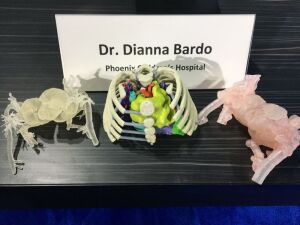by
John W. Mitchell, Senior Correspondent | November 28, 2017

Peds 3D models, green mass in
center represents a tumor
CHICAGO — The science of 3-D imaging to transform complicated MR images into a 3-D surgical model is delicate and complicated. But for one doctor, the most profound use of this science permits a child to whack a real-life replica of their cancer tumor with a hammer.
Dr. Dianna Bardo, director of body MR and co-director 3-D Innovations Laboratory at Phoenix Children’s Hospital shared that patient story early Monday morning at RSNA 2017. She reviewed several cases – from conjoined twins to kids with tumors wrapped around their internal organs – where 3-D modeling saved young lives and gave much-needed insight to patients and their parents.
Her presentation was part of an announcement today by Phillips of their agreements with 3D Systems and Stratasys to provide 3-D models via imaging transferred from Philips IntelliSpace Portal 10 visualization platform.



Ad Statistics
Times Displayed: 46235
Times Visited: 1406 MIT labs, experts in Multi-Vendor component level repair of: MRI Coils, RF amplifiers, Gradient Amplifiers Contrast Media Injectors. System repairs, sub-assembly repairs, component level repairs, refurbish/calibrate. info@mitlabsusa.com/+1 (305) 470-8013
According to Philips, the system is the first such platform to feature an embedded 3-D modeling application for creating and exporting 3-D models intuitively into the clinical workflow. A suite of clinician-focused rendering and editing tools from across IntelliSpace Portal 10 applications helps assure the model reflects the true patient anatomy.
For clinicians and patients, this capability breaks new ground.
“I had a congestive heart patient who was ten years old and needed surgery," she told HCB News. "The patient had surgery in the past. But this time she was able to hold an exact replica of her heart in her hands while I explained why the plumbing of her heart didn’t work and what we were going to do to fix it. And her mother told me that she never really understood the problem with her daughter’s heart until she saw that model.”
Letting pediatric cancer patients hit a 3-D model of their tumor with a hammer imparts a sense of empowerment to a child. She said 3-D modeling offers an “incredible sense of relief” for patients and families – and is also a valuable teaching tool for medical residents.
According to Kevin Lev, senior product manager for IntelliSpace Portal 10, 3-D modeling applications are poised for exponential growth.
“There is strong clinical evidence for 3-D modeling to radically extend the radiologist beyond imaging and … into the surgery suite,” he said. “This announcement offers a new [imaging] end-to-end solution.”
Lev noted that the partnerships with 3D Systems and Stratasys would enable hospitals that cannot fund their own 3-D model program to bring it to their patients. According to representatives from both 3-D companies, the turnaround time for prototypes and final models is only a few days.
Bardo said that Philips arrangement with the two 3-D printing companies promises to be a “successful and fruitful collaboration” for the hospital’s pediatric patients.

